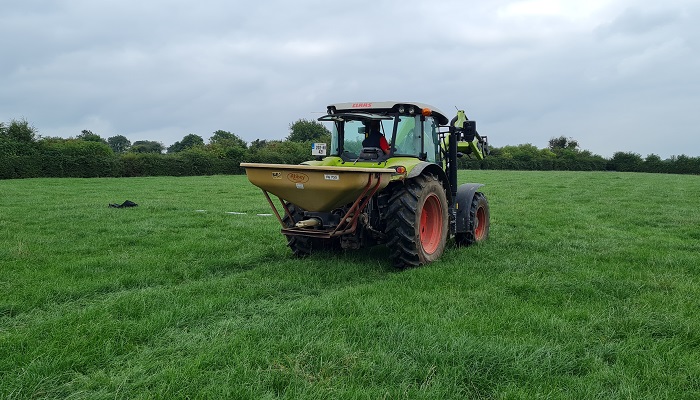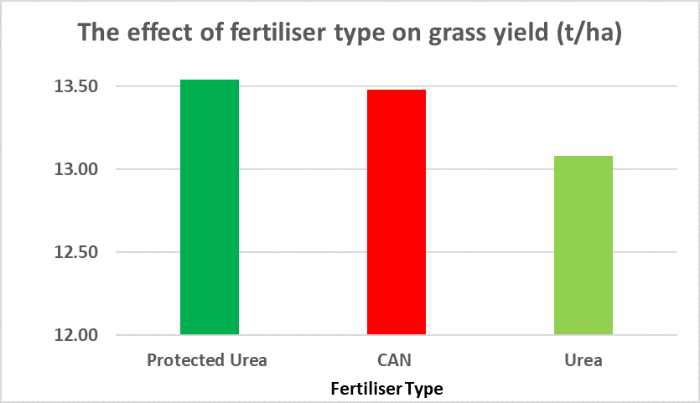28 January 2025
Why Protected Urea?

From reducing greenhouse gas emissions associated with fertiliser use to being a proven and cost-effective solution, Signpost Programme Training and Development Specialist, Mark Plunkett outlines why protected urea should be on every fertiliser shopping list this year.
Agriculture is one of the primary sources of greenhouse gas emissions (GHGs) accounting for 38% of all Irish emissions. Switching to a sustainable type of fertiliser such as protected urea is the first step to directly reducing GHGs and ammonia emissions, improving air quality and meeting our national and EU emission targets. It is well proven that GHG emissions are a key driver of climate change and choosing a sustainable fertiliser nitrogen (N) source is key part of the solution for the agricultural sector.
Reduces GHG emissions
Did you know that nitrate-based fertilisers (e.g. Calcium Ammonium Nitrate – CAN) produce one of the most powerful greenhouse gases called ‘Nitrous Oxide (N₂O)’, which accounts for ~ 20% of GHG emissions from agriculture. One kilo of N₂O has a global warming potential 300 times that of one kilo of carbon dioxide. Furthermore it lasts in the atmosphere for over 100 years compared to 12 years for methane. Nitrous oxide, a climate pollutant, doesn’t have a direct impact on the human body but is still harmful to our health. By trapping the earth’s heat in the atmosphere, greenhouse gases lead to warmer temperatures, which in turn accelerates the rate of climate change – rising sea levels, heat related deaths, more extreme weather events such as drier summers and wetter winters and the survival of pests and diseases.
Number one technology to reduce ammonia emissions
Agriculture produces 99% of Ireland’s ammonia emissions and results in poor air quality, which has negative impacts on human and animal health. Ammonia losses occur after the application of either ordinary urea fertiliser or cattle slurry. Application of cattle slurry in springtime with low emission slurry spreading equipment (LESS) reduces ammonia losses by 50%. Switching from ordinary urea fertiliser to protected urea reduces ammonia losses by up to 79%. Reducing ammonia / N losses from cattle slurry and urea fertilisers helps maintain more N is the system to grow grass. These two technologies combined can reduce ammonia emissions by 80% from agriculture.
Currently Ireland is in breach of EU ammonia emission targets and facing fines to the tune of €8.2 billion per year. Making the switch from traditional N based fertilisers (CAN / Urea) to Protected Urea delivers a double win for agriculture from reducing harmful air pollutants to improving the sustainability now and in the years ahead.
A proven technology
Protected urea is a proven technology and is quite unique to Irish farming systems, as it is the most effective technology to reduce N₂O emissions from our heavy high organic matter grassland soils. The main pathway of N loss on these soils is through a process called denitrification, which takes place directly after the application of nitrate based fertiliser such as CAN 27% N. The amount of N lost as nitrous oxide is quite small (~1.5 kg N₂O) but has a large global warming potential and very harmful when emitted to the atmosphere. Switching from CAN to protected urea has been proven to be most effective in reducing GHG’s and ammonia losses while retaining more N to grow grass. Figure 1 below shows the results from an extensive grazing study conducted over 10 site years at four locations across Ireland, and shows that protected urea grows similar grass to CAN and significantly more grass than ordinary urea.
Figure 1. Grazed grass yields over 10 site years for different fertiliser N types. (Murray, A., et al, 2023)

Reducing farm emissions
Agriculture is required to reduce total GHG emissions by 25% by 2030. In 2023, the EPA reported that agriculture is making good progress with a 4.6% reduction in farm emissions mainly driven by an 18% reduction in fertiliser N. Since 2018, fertiliser use on farms has reduced from 408,000 tonnes in 2018 to 310,000 tonnes in 2024. This has been driven by the fertiliser crisis in 2022/23 resulting in higher fertiliser prices. While on farm, the adoption of LESS technology and better timings of N fertilisers have all contributed to reduced N use.
This reduction in chemical fertiliser N aligns with Climate Action Plan target of 300,000 tonnes of chemical N by 2030. The first step to reduce farm emissions has been taken by farmers by reducing N use. The primary challenge now will be to maintain current N use through the further adoption of farm technologies, such as improving soil pH, soil fertility, clover swards, to making adjustments for N in cattle slurry to reduce our reliance on chemical fertilisers.
The second Climate Action Plan target is to replace 80 to 90% of CAN based fertilisers with protected urea. This would further reduce GHG emissions and is the next major step along the road to meeting emission reduction targets by 2030. For example, take a dairy farm where all the straight N applied as CAN is replaced with protected urea, total farm emissions are reduced by ~ 8%. This is equivalent to reducing the emissions from 10% of the cows on the farm. Protected urea is currently the most effective technology as it can deliver ~30% of our 2030 sectoral emission reduction target.
Cost effective option
Protected urea is one the most practical and cost effective solutions available for agriculture to reduce GHGs, increase farm sustainability and reduce farm fertiliser costs. The adoption of other low carbon technologies (e.g. electric car) generally comes at additional costs. Protected urea is quite the opposite, as it reduces emissions from fertilisers while maintaining sufficient rates of N which are central to our farm production systems. Fertiliser is a large on farm cost but making the switch from CAN to protected urea reduces the farm fertiliser N bills by ~ 15 to 20%.
For more information on protected urea, visit the Signpost Programme webpage.
